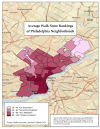Neighborhood Walkability as a Risk Factor for Preterm Birth Phenotypes in Two Philadelphia Hospitals from 2013-2016
- PMID: 37297536
- PMCID: PMC10252293
- DOI: 10.3390/ijerph20115932
Neighborhood Walkability as a Risk Factor for Preterm Birth Phenotypes in Two Philadelphia Hospitals from 2013-2016
Abstract
A total of one in ten infants is born preterm in the U.S. with large racial disparities. Recent data suggest that neighborhood exposures may play a role. Walkability-how easily individuals can walk to amenities-may encourage physical activity. We hypothesized that walkability would be associated with a decreased risk of preterm birth (PTB) and that associations would vary by PTB phenotype. PTB can be spontaneous (sPTB) from conditions such as preterm labor and preterm premature rupture of membranes, or medically indicated (mPTB) from conditions such as poor fetal growth and preeclampsia. We analyzed associations of neighborhood walkability (quantified by their Walk Score® ranking) with sPTB and mPTB in a Philadelphia birth cohort (n = 19,203). Given racial residential segregation, we also examined associations in race-stratified models. Walkability (per 10 points of Walk Score ranking) was associated with decreased odds of mPTB (aOR 0.90, 95% CI: 0.83, 0.98), but not sPTB (aOR 1.04, 95% CI: 0.97, 1.12). Walkability was not protective for mPTB for all patients; there was a non-significant protective effect for White (aOR 0.87, 95% CI: 0.75, 1.01), but not Black patients (aOR 1.05, 95% CI: 0.92, 1.21) (interaction p = 0.03). Measuring health effects of neighborhood characteristics across populations is key for urban planning efforts focused on health equity.
Keywords: pregnancy; preterm birth; racial disparities; walkability.
Conflict of interest statement
The authors declare no conflict of interest.
Figures



References
-
- Passini R., Cecatti J.G., Lajos G.J., Tedesco R.P., Nomura M.L., Dias T.Z., Haddad S.M., Rehder P.M., Pacagnella R.C., Costa M.L., et al. Brazilian multicentre study on preterm birth (EMIP): Prevalence and factors associated with spontaneous preterm birth. PLoS ONE. 2014;9:e109069. doi: 10.1371/journal.pone.0109069. - DOI - PMC - PubMed
-
- Ananth C.V., Friedman A.M., Goldenberg R.L., Wright J.D., Vintzileos A.M. Association between Temporal Changes in Neonatal Mortality and Spontaneous and Clinician-Initiated Deliveries in the United States, 2006–2013. JAMA Pediatr. 2018;172:949–957. doi: 10.1001/jamapediatrics.2018.1792. - DOI - PMC - PubMed
Publication types
MeSH terms
Grants and funding
LinkOut - more resources
Full Text Sources

